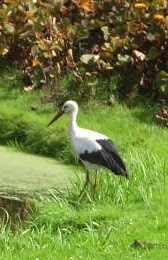
---------->
This is the bird that I saw which I thought was a blue heron but which, after further contemplation seemed not to be. I thought it was the wrong size as well. After extensive Wikipedia research and and "birds of Europe" Google searches , I think that I was wrong on both counts. It seems like this bird is probably a Grey Heron, which leaves throughout Europe. Blue Herons and Grey Herons are the same size but Blue Herons are only very rarely seen in Europe. Also, if you note the dark feathers on the wings, I think they match the Grey Heron better.


The picture on the left is a Wikipedia picture of a Blue Heron. The picture on the right is a Wikipedia picture of a Grey Heron. I think that this now seems like a pretty clear identification.

With the stork, however, I think I was correct. This appears to be a European or White Stork and it is, indeed, the kind that delivers babies. The picture on the right is the one I took and the picture below is a Wikipedia picture of a pair of White Storks.
Hannah, I'm hoping that the university offers some classes on "the facts of life". I think it may be time for you to hear about "where babies come from" and whether or not storks are actually involved.
ReplyDelete